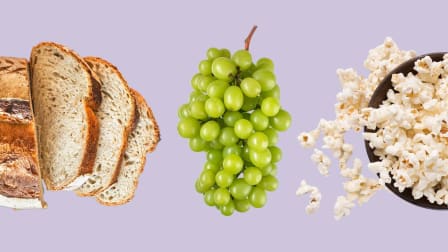Facts About Good Fats
We've got answers to your questions about healthy fats and not so healthy ones

Fat has been a dietary villain for decades. Because saturated fat, in particular, was found to raise cholesterol levels and thereby increase heart disease risk, and too much fat had been linked to an increase in cancer risk, nutrition experts advised us to cut back on fat to protect our health. And we did: Fats as a portion of our diets dropped from 42 percent of total calories in the 1970s to 34 percent today.
But recently the pendulum has swung back. “The take-home message should be to stop fearing fat,” says Dariush Mozaffarian, MD, dean of the Friedman School of Nutrition Science and Policy at Tufts University in Boston. Still, all fats are not created equal, and some are better for you than others. Here are answers to the most pressing questions about good and bad fats.
How Much Do You Need to Worry About Fat?
Fat is a key component of a healthy diet, and some types are called essential, which means your body can’t make them on its own. Among other benefits, “fat makes food taste better, makes you feel full longer, and helps your metabolism,” Mozaffarian says.
Which Ones Are Good Fats?
All fats are a mixture of saturated, monounsaturated, and polyunsaturated fatty acids. Within each fatty acid group are different versions of that type of fat—for instance, there are omega-3 and omega-6 polyunsaturated fats. The unsaturated fats are the healthiest. The highest levels are in seafood and plant foods, including nuts, avocados, olives, and plant oils, such as olive and canola oils. These foods have additional healthy components, like antioxidants, minerals, and fiber.
“Healthy plant oils are really what people should be eating more of, not all fats,” Mozaffarian says. Replacing saturated fats with unsaturated fats lowers heart disease risk by 17 to 25 percent. Unsaturated fats don’t raise cancer risks and may protect against certain cancers.
Should You Limit Saturated Fat?
It’s controversial. Some scientists believe its heart risks dictate the need to minimize intake, while others say its health effects can be fully understood only when you consider the food it’s coming from. Still, until more is known, it’s wise to go easy on saturated fat—the DGA recommends keeping it under 10 percent of daily calories. (That’s about 22 grams for someone who eats 2,000 calories per day.) Strategies include cutting back on desserts and sweet snacks and limiting saturated-fat–rich tropical oils (palm, palm kernel, and coconut oils).
“Red meat is okay once or twice a week in the context of a heathy diet, but it’s best if you choose lean cuts,” says Penny Kris-Etherton, PhD, the Evan Pugh professor of nutritional sciences at Penn State University in State College. However, some evidence suggests that full-fat dairy products such as cheese and yogurt may be associated with a lower risk of stroke, heart disease, and type 2 diabetes.
What About Trans Fats?
There are two types of trans fats: naturally occurring and artificial. Naturally occurring trans fats, found in small amounts in dairy and meat, aren’t considered a health risk. Artificial trans fats come in the form of partially hydrogenated oils. These are created by adding hydrogen to vegetable oils, which makes them solid; they cause inflammation in the body and raise the risk of heart disease and diabetes.
Partially hydrogenated oils used to be used liberally in packaged and processed foods, but per the FDA, most food manufacturers had to stop using them in their products in 2018. However, some had until the beginning of 2021 to remove them from their products. Kris-Etherton suggests checking your pantry for any older packaged foods, such as microwave popcorn, that list partially hydrogenated oils among the ingredients, and tossing them.
Are Some Oils, Such As Canola, Toxic?
Canola, safflower, and other seed oils have been targeted for their high levels of omega-6 polyunsaturated fats, which critics say push the ratio of omega-3 to omega-6 fats in our diets out of a healthy range. Although scientists initially thought this ratio was important, Mozaffarian says, it has been shown to matter only in rodents, not in humans. Omega-6 fats are essential fats—our bodies can’t make them—that improve heart health and insulin sensitivity and can tamp down inflammation. Also, it’s possible that some critics may be confusing industrially refined seed oils with unhealthy, industrially produced trans fats and assuming, incorrectly, that processing makes seed oils harmful.
Do High-Fat Diets Like Keto Work?
They do. People tend to lose weight more successfully on low-carbohydrate, high-fat (LCHF) diets such as keto than on low-fat diets, especially if their insulin or blood sugar is out of whack. “Bad” LDL cholesterol may rise in some, but it’s likely to be accompanied by improvements in “good” HDL cholesterol, triglycerides, and other metabolic syndrome factors. And although the fats in LCHF diets typically are saturated fats, it’s possible to rely on healthy unsaturated plant fats instead. However, going low-carb means that you miss out on the fiber and antioxidants in whole grains and fruit, which studies have shown lower heart disease, cancer, and diabetes risk.
How Do You Get Enough Good Fats?
Rather than counting fat grams, Mozaffarian advises simply following a whole-foods, plant-based diet. “That’s a healthier diet and also good for long-term weight maintenance,” he says. Fill your plate with whole grains, legumes, nuts, fruits, and vegetables. “Use lots of extra-virgin olive oil, cook with healthy plant oils, and use them liberally in salads,” he says. Keep highly processed meats, sugars, and refined starches to a minimum. This approach will naturally increase healthy fats and limit unhealthy ones.
Editor’s Note: This article also appeared in the September 2022 issue of Consumer Reports On Health.




















